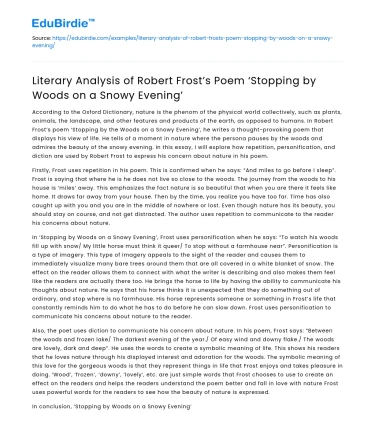According to the Oxford Dictionary, nature is the phenom of the physical world collectively, such as plants, animals, the landscape, and other features and products of the earth, as opposed to humans. In Robert Frost’s poem ‘Stopping by the Woods on a Snowy Evening’, he writes a thought-provoking poem that displays his view of life. He tells of a moment in nature where the persona pauses by the woods and admires the beauty of the snowy evening. In this essay, I will explore how repetition, personification, and diction are used by Robert Frost to express his concern about nature in his poem.
Firstly, Frost uses repetition in his poem. This is confirmed when he says: “And miles to go before I sleep”. Frost is saying that where he is he does not live so close to the woods. The journey from the woods to his house is ‘miles’ away. This emphasizes the fact nature is so beautiful that when you are there it feels like home. It draws far away from your house. Then by the time, you realize you have too far. Time has also caught up with you and you are in the middle of nowhere or lost. Even though nature has its beauty, you should stay on course, and not get distracted. The author uses repetition to communicate to the reader his concerns about nature.
Save your time!
We can take care of your essay
- Proper editing and formatting
- Free revision, title page, and bibliography
- Flexible prices and money-back guarantee
In ‘Stopping by Woods on a Snowy Evening’, Frost uses personification when he says: “To watch his woods fill up with snow/ My little horse must think it queer/ To stop without a farmhouse near”. Personification is a type of imagery. This type of imagery appeals to the sight of the reader and causes them to immediately visualize many bare trees around them that are all covered in a white blanket of snow. The effect on the reader allows them to connect with what the writer is describing and also makes them feel like the readers are actually there too. He brings the horse to life by having the ability to communicate his thoughts about nature. He says that his horse thinks it is unexpected that they do something out of ordinary, and stop where is no farmhouse. His horse represents someone or something in Frost’s life that constantly reminds him to do what he has to do before he can slow down. Frost uses personification to communicate his concerns about nature to the reader.
Also, the poet uses diction to communicate his concern about nature. In his poem, Frost says: “Between the woods and frozen lake/ The darkest evening of the year./ Of easy wind and downy flake./ The woods are lovely, dark and deep”. He uses the words to create a symbolic meaning of life. This shows his readers that he loves nature through his displayed interest and adoration for the woods. The symbolic meaning of this love for the gorgeous woods is that they represent things in life that Frost enjoys and takes pleasure in doing. ‘Wood’, ‘frozen’, ‘downy’, ‘lovely’, etc. are just simple words that Frost chooses to use to create an effect on the readers and helps the readers understand the poem better and fall in love with nature Frost uses powerful words for the readers to see how the beauty of nature is expressed.
In conclusion, ‘Stopping by Woods on a Snowy Evening’ is a fantastically written poem that captures Robert Frost’s view of how life should be. In the end, Frost is saying that people should want to enjoy special times in life, and they can. He is also saying, however, that if one makes a promise to do something, or has a job to accomplish, the work should always come before enjoying the things people love to do in life. Overall, Frost uses many different ways of expressing his concerns about nature, especially imagery and symbolic meanings. In his poem, he talks about the beauty of nature and captures its essence. He makes the reader feel like nature is home.






 Stuck on your essay?
Stuck on your essay?

